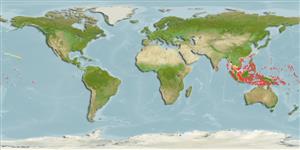Common names from other countries
Environment: milieu / climate zone / depth range / distribution range
Ecologie
marien rifbewoner; diepte 20 - 50 m (Ref. 90102). Tropical; 30°N - 12°S
Western Pacific: southern Honshu, Japan to the Great Barrier Reef and New Caledonia. Reported from the Similan Islands in the Andaman Sea and Guam. Recently recorded from Tonga (Ref. 53797).
Grootte / Gewicht / Leeftijd
Maturity: Lm ? range ? - ? cm
Max length : 60.0 cm SL mannelijk / geslacht onbekend; (Ref. 48637)
Dorsale stekels (totaal) : 5; Dorsale zachte stralen (totaal) : 27 - 30; Anale stekels: 2; Anale zachte stralen: 26 - 30. Lacks a horn, has numerous black close-set spots on the upper half of its body and tail, and is white ventrally. Body elongate, its depth 3.3 to 3.7 times in SL (Ref 9808).
Inhabits coastal to outer reef slopes subject to strong currents. Sometimes in large schools (Ref. 48637). Generally uncommon species found in steep outer reef drop-offs (Ref. 9710). Usually found in waters deeper than 6 m. Feeds on zooplanktons (Ref. 90102). Solitary or in groups (Ref. 37816).
Levenscyclus en paargedrag
Maturities | Voortplanting | Spawnings | Egg(s) | Fecundities | Larven
Myers, R.F., 1991. Micronesian reef fishes. Second Ed. Coral Graphics, Barrigada, Guam. 298 p. (Ref. 1602)
Status op de Rode Lijst van het IUCN (Ref. 130435)
CITES (Ref. 128078)
Not Evaluated
Gevaar voor de mens
Harmless
Gebruik door de mens
Visserij: commercieel; Aquarium: Commercieel
Tools
Speciale rapporten
Download XML
Internetbronnen
Estimates based on models
Preferred temperature (Ref.
115969): 24.4 - 28.5, mean 27.6 (based on 73 cells).
Fylogenetische diversiteitsindex (Ref.
82804): PD
50 = 0.5000 [Uniqueness, from 0.5 = low to 2.0 = high].
Bayesian length-weight: a=0.01995 (0.00906 - 0.04395), b=3.00 (2.82 - 3.18), in cm Total Length, based on LWR estimates for this Genus-body shape (Ref.
93245).
Trofisch niveau (Ref.
69278): 2.9 ±0.33 se; based on food items.
Weerstandsvermogen (Ref.
120179): Gemiddeld, minimale populatieverdubbelingstijd 1,4-4,4 jaar (Preliminary K or Fecundity.).
Fishing Vulnerability (Ref.
59153): Moderate to high vulnerability (49 of 100).
